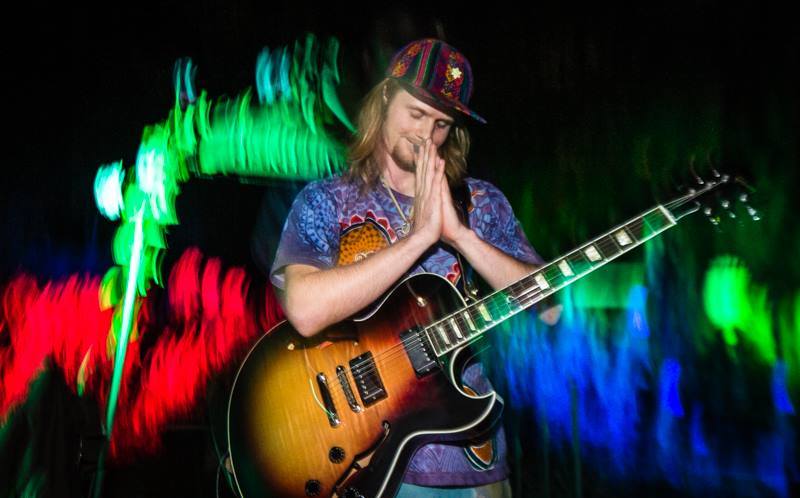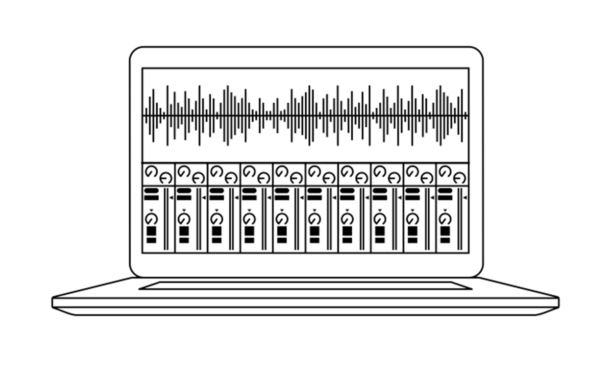You may or may not have heard of Cualli, a well-seasoned producer who has just released his project “The Monk of Chunk” on Gravitas Recordings. Based out of Colorado, his rumbling bass and eclectic combination of sounds have left us floored. We sat down with Cualli and spoke about his journey into music, the meaning behind his name, and production techniques.
Gravitas: Can you tell us how you got started?
Cualli: I started using Ableton 11 years ago when I was still in college. I didn’t have a ton of time to work on music but I knew it was what I wanted to be doing. So on my breaks from school, I would dedicate time for that. After I graduated in 2010, I’ve been putting a lot of time and energy into it.
Back in the day, I was inspired by metal and punk rock. From there, I got into jam bands and then STS9 flipped me into the electronic scene. After that, I started getting really excited about Bassnectar, the Glitch Mob, and finally things just rolled along.
Recently, I’ve been listening to Tipper, NOISIA and Ivy Lab. I like their half-time stuff, and the NOISIA production is just insane. The first two tunes I created, “Tiger Prowl” and “Binary Star” were inspired by NOISIA, along with their collab by Ivy Lab and Mono/Poly.
How do you feel about learning from your inspirations and trying to replicate moods or feelings you felt when listening to other songs?
To me, it seems like most of what I am inspired by – those guys were trying to do something they heard before, too. When looking at sound design and the beats realm, that’s when people start getting really original and things start getting really out there. But I think artists will draw inspiration from whatever they’re into at the time.
Trying to straight up copy someone and sell it, well there’s a certain limit to that perspective. But trying to get your production to sound as good as whoever you admire is a learning tool.
A lot of times, maybe you come up with something that sounds like someone else, but it’s usually something no one has done before. Figuring that whole process out is an inspiration on its own, like a fire under your butt that gets you motivated to tweak with stuff for a long time. [Laughs] That’s really what it takes.
What plug-ins do you mainly use?
I got a UAD card a couple years ago, and that really got me into the world of analog mixing gear and mixing engineering in general. I read “The Mixing Engineer’s Handbook” and learned a lot.
In the digital world, we have Ableton, compressors and the EQ8. All of these things are designed to be particularly clean [so nothing really goes wrong.] But they were developed and programmed to try to replicate things we had back then. When we had color, character and saturation for sound that was really cool for me because I was never into distortion or saturation until I found the right plug-ins.
I recently got Trash2 from iZotope and I like how I can do specific things with it. I use the EQ8, Ableton and Pro-Q 2 from FabFilter. Pretty much everything from FabFilter is really high quality. I like Brainworx and as far as effects go, the u-he (people that make Zebra) effects bundle is really cool. In particular, for making weird, digital sound designs, I like to use the Granulator effect.
These days, I use flangers from Phase Mistress II, Channel Strip I, and UAD. I was looking for flangers and when I found the right one I thought to myself, “Where have you been all my life?” I love the sound of flangers, so I was happy to find one that fit my style. I also use Slate, because they have the virtual mix rack and the Neve EQ. The emulation on there is really nice because rather than just taking a surgical approach, you can add lots of color and saturation which makes it interesting.
The plug-ins I use most often varies because everything needs something different. The biggest lesson is to be patient and try different things so something sounds the way I want it to sound. I think a lot of times, the tendency is to go through something and say, “Okay, this is good enough.” Now, good enough isn’t enough for me. I like to keep pushing the limit by trying different plug-ins and figuring out what it needs until I’m truly satisfied with the outcome.
What soft synths do you use?
For synths, I use Serum. I know that’s everyone’s “bae” right now but it’s really versatile and sounds great. Other ones I’ll use are Zebra and Sylenth. The frequency modulation
synthesis in operator is great and isn’t so hard on the CPU so I find that really nice.
What does your writing process look like? Do you open up a plug-in and just start sound designing, or do you have a possible melody in mind?
“I like to listen in the recordings and get inspiration from nature. Randomly throwing a bird sound onto a beat messes with the rhythm in a certain way that I would’ve never thought of on my own.”
It varies; I don’t have a particular formula. A lot of the time, I will have an idea of what I want to do, so I’ll aim to make that idea work. If I don’t, I’ll start off by writing a beat with field recordings. I like to listen in the recordings and get inspiration from nature. Randomly throwing a bird sound onto a beat messes with the rhythm in a certain way that I would’ve never thought of on my own.
Nature in general has the trippiest sounds, so with a lot of my music, I’m trying to bring the two together. The sounds of the bugs or the rhythm of the jungle are all components I try to integrate.
Can you go into detail with that? How do you go about making such complex and detailed sounds?
Having personal experiences in nature where something plays with my brain in a fun way is where a lot of my inspiration comes from. Developing an ear for what I initially want something to sound like is square one. Going in with synths and effects, I tweak with it until I find a sound that satisfies that ear.
The trick is, you need to broaden your knowledge base by learning various tools and understand what they’re meant for. Having an ear for what you want and dedicating countless hours to the process are paramount in my creations.

Do you break production up into sessions where you dedicate time to experiment and not actually try to make a track?
I don’t. Although I know that’s a really organized way of producing, I just drag in tracks from previous sets into new projects. Generally, I will keep using the last project I did and from that, start something new. That way, things can keep growing within itself. Everyone is different and this is what has worked for me so far. It allows me to get way more specific, intricate, and customized.
Do you write your tracks with your live sets in mind?
It’s a fair mixture of both. I started writing music because I didn’t have a band at the time, so I wanted to have songs ready for the future. Over the past few years, I’ve paid more attention to DJ’ing and making tunes that are more beat-oriented. It’s difficult for me to specifically control my creative output. I have to sort of just go with whatever I hear in my head. I like it when everything is found in the flow of things.
What made you want to get into music to begin with?
As far as production goes, when I first got my laptop in college, the trigger to my interest was the type of music I was hearing and the concerts I was seeing. Being inspired, I really wanted to share something, even if I could hear things and not be able to make them yet. [Laughs] But honestly, I’m not sure how I got to this point. I don’t know what I’m doing here. Just following the rabbit down the rabbit hole.
Did you ever learn to play an instrument?
My dad used to play guitar and sing. In his day, he would perform music at parties and when I was a kid he used to play at nursing homes. He bought me my first electric guitar when I was in the fifth grade. I thought to myself, “Oh this is going to be so awesome!” Once I tried playing it, I realized I had a lot of work to do. In middle school, I started a little band and that’s what helped me learn to play the guitar. It’s thanks to my dad’s gift that my passion for music was prompted.

Who is your most important and influential teacher?
Chris Cox, who is known as Omega. He is one of the friendliest dudes and his production knowledge is on point. He always wanted to help everyone out by inviting people into his studio. I finally did that at some point and I offered him some money and he said, “No, but maybe you could play guitar on a track sometime.”
He ended up sending my brother an unreleased track and I realized I wanted to put some guitar or organ sounds onto it. After he sent me the song, I re-worked it and that was the first of many collaborations we’ve done. It was called “Global Deceleration.” It came out through Simplify and Crystal Method played it. Once it got a lot of recognition, we decided to do it again. That’s when we started Project YuYu. Working with Chris, I learned so many technicalities and learned so much from him overall.
If you could collab or mentor with somebody, who would it be?
NOISIA or Tipper would be cool. My process is such a personal thing that it’s really hard to work with other people. Even more than just working with those guys, I would love to just be a fly on the wall and watch what they’re doing.
It is hard as electronic musicians to collaborate. Sometimes it’s more of a collaboration to just let their knowledge and your knowledge exchange, and then go make music separately.
Yeah, I think so too. Along with the teacher thing, Chris has been a really great friend – we learn so much from each other. That’s a lot of what keeps it going. Even just people sharing stuff on the Internet, it’s pretty cool that people can connect like that so easily these days.
If you could go back in time knowing what you know now, what would you tell yourself to focus on or learn first?
Well, honestly, with my creative process I feel like I’m really happy with the way things turned out. I mean, because I’ve always done whatever I wanted to do, like learn whatever I wanna learn about, I don’t really have any regrets about how the whole process has happened.
But what I would tell myself is be more careful with my ears, because sitting in front of monitors and doing shows and stuff like that…I’ve been wearing ear plugs for a minute, but it’s still just hasn’t been enough. Honestly, I would’ve told myself back when I was playing in bands and stuff like that, just because it’s so fucking loud. Ears are so important and losing hearing sucks, so that would be the main thing, I think.
We all know we should put the earplugs in, but how many of us do it? I agree with that hardcore, that should be in every producer’s toolkit.
Yeah, and monitor at reasonable levels too.
“But what I would tell myself is be more careful with my ears, because sitting in front of monitors and doing shows and stuff like that…”
Yeah, right. Generally, if you do a mix on quiet speakers, it’s gonna sound good loud, but it doesn’t translate the other way as well. Mixing something loud doesn’t necessarily sound good quiet, so I think it’s good to do both. I really only save the loud stuff for particular occasions and not do it for super long.
For Monk of Chunk, how did the writing process go as far as: how long were these tunes cooking, how long were you working with Gravitas to release them, and how do you feel about it now that it’s released?
Cool. Yeah, let’s see. So the older ones would be “Cacao Bell” and “Feather Ruffler,” and those I actually made in Costa Rica about this time last year. Those happened super quickly, relatively. I think both of those tracks came out in 4 days or something like that.
The most recent one that I did while I’ve been here, that took me like a week. My writing process right now has really slowed down. I say that, but the mix on “Cacao Bell” was absolutely dreadful at first, and I even thought about just scrapping that tune, just not releasing it or whatever, but my partner really liked it, so she inspired me to keep it around.
So I wrote those tunes in a few days but then it really took a lot of work afterward to make them sound right. But the first two ones on there, “Tiger Prowl” and “Binary Star,” those are the newest ones. Those were written in, I wanna say, September of 2016 or something like that. There were 10 tunes that I sent to Gravitas, and the 5 on [The Monk of Chunk] are the ones they picked out because they felt like that would be the most cohesive. I was surprised at some of the ones they picked too, which was kinda cool ‘cause I was like, “I got these other ones to hold onto, some magic beans in my pocket.”
And the last one, that was written somewhere in the middle. Getting all the mixing and mastering done was a long haul; marathoning mixing and mastering to make it sound good, a lot of time on that.

What number project is this?
[Counting out loud] I think this is 7, but I’m probably forgetting something. One of those was an EP before, so…Working with Gravitas has been really cool though, I’ve gotten a lot of good feedback from them on released stuff and their critical input has been really good for me. I feel like the release has done really well, relatively, to what I’ve done before.
My last release was with Merkaba and that one did really well. This one was with Gravitas and it’s gotten even more reach. A lot of my homies seem really stoked on it and happy about it, so it’s been really cool getting it out there and letting it do its thing out in the big world.
Last question, where does your name come from?
That was a part of college. That was a world philosophy class, and we were talking about Aztec philosophy. That teacher specialized in Aztec stuff, so cualli means “good.” Within their system of what good is, they have something called “Teotl,” it’s kind of similar to Taoism. My understanding of it is they thought of the Earth being this razor sharp mountain traverse. You’ve got cliffs on either side and what’s “good,” or cualli, is that path that gets you across the traverse.
That’s a cool way to think about it. The way. The path.



Sorry, but you have already liked this article.